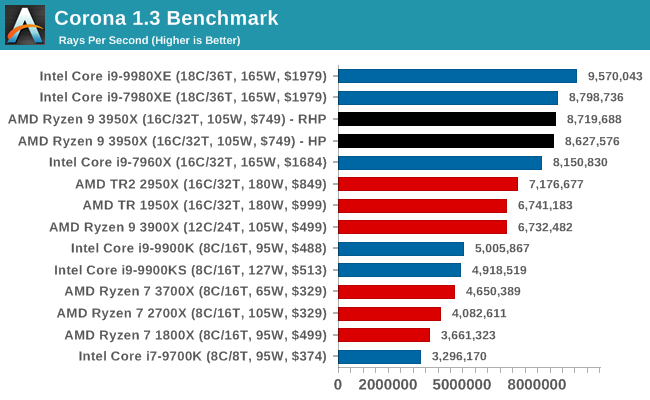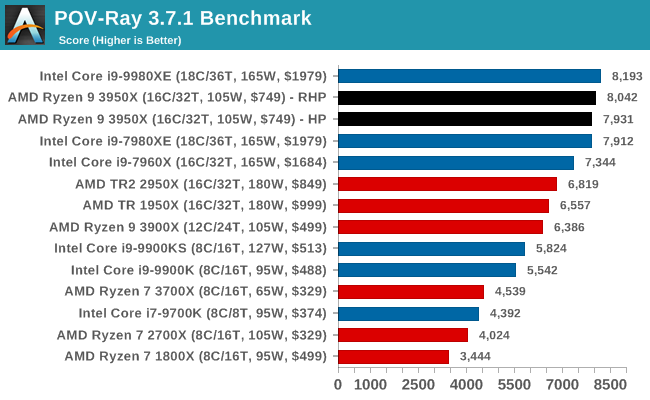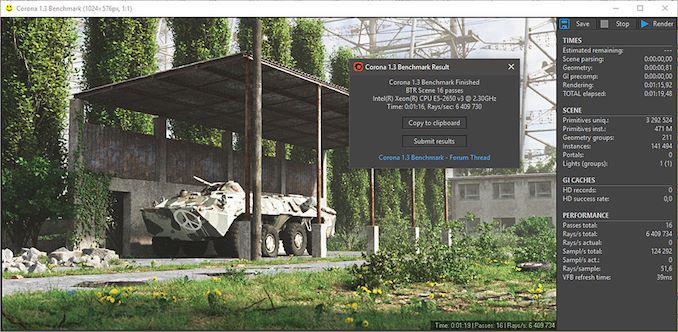The AMD Ryzen 9 3950X Review: 16 Cores on 7nm with PCIe 4.0
by Dr. Ian Cutress on November 14, 2019 9:00 AM ESTCPU Performance: Rendering Tests
Rendering is often a key target for processor workloads, lending itself to a professional environment. It comes in different formats as well, from 3D rendering through rasterization, such as games, or by ray tracing, and invokes the ability of the software to manage meshes, textures, collisions, aliasing, physics (in animations), and discarding unnecessary work. Most renderers offer CPU code paths, while a few use GPUs and select environments use FPGAs or dedicated ASICs. For big studios however, CPUs are still the hardware of choice.
All of our benchmark results can also be found in our benchmark engine, Bench.
Corona 1.3: Performance Render
An advanced performance based renderer for software such as 3ds Max and Cinema 4D, the Corona benchmark renders a generated scene as a standard under its 1.3 software version. Normally the GUI implementation of the benchmark shows the scene being built, and allows the user to upload the result as a ‘time to complete’.
We got in contact with the developer who gave us a command line version of the benchmark that does a direct output of results. Rather than reporting time, we report the average number of rays per second across six runs, as the performance scaling of a result per unit time is typically visually easier to understand.
The Corona benchmark website can be found at https://corona-renderer.com/benchmark

Intel's HEDT chips are quite good at Corona, but if we compare the 3900X to the 3950X, we still see some good scaling.
Blender 2.79b: 3D Creation Suite
A high profile rendering tool, Blender is open-source allowing for massive amounts of configurability, and is used by a number of high-profile animation studios worldwide. The organization recently released a Blender benchmark package, a couple of weeks after we had narrowed our Blender test for our new suite, however their test can take over an hour. For our results, we run one of the sub-tests in that suite through the command line - a standard ‘bmw27’ scene in CPU only mode, and measure the time to complete the render.
Blender can be downloaded at https://www.blender.org/download/

AMD is taking the lead in our blender test, with the 16-core chips easily going through Intel's latest 18-core hardware.
LuxMark v3.1: LuxRender via Different Code Paths
As stated at the top, there are many different ways to process rendering data: CPU, GPU, Accelerator, and others. On top of that, there are many frameworks and APIs in which to program, depending on how the software will be used. LuxMark, a benchmark developed using the LuxRender engine, offers several different scenes and APIs.
In our test, we run the simple ‘Ball’ scene on both the C++ code path, in CPU mode. This scene starts with a rough render and slowly improves the quality over two minutes, giving a final result in what is essentially an average ‘kilorays per second’.

Despite using Intel's Embree engine, again AMD's 16-cores easily win out against Intel's 18-core chips, at under half the cost.
POV-Ray 3.7.1: Ray Tracing
The Persistence of Vision ray tracing engine is another well-known benchmarking tool, which was in a state of relative hibernation until AMD released its Zen processors, to which suddenly both Intel and AMD were submitting code to the main branch of the open source project. For our test, we use the built-in benchmark for all-cores, called from the command line.
POV-Ray can be downloaded from http://www.povray.org/

POV-Ray ends up with AMD 16-core splitting the two Intel 18-core parts, which means we're likely to see the Intel Core i9-10980XE at the top here. It would have been interesting to see where an Intel 16-core Core-X on Cascade would end up for a direct comparison, but Intel has no new 16-core chip planned.











206 Comments
View All Comments
Devo2007 - Thursday, November 14, 2019 - link
First page "As we move into 2019" - should be "As we move into 2020"plp1980 - Thursday, November 14, 2019 - link
Is says as we move "through" not as we move "into"Ryan Smith - Thursday, November 14, 2019 - link
It did originally say "into". We've since fixed it.=)Netmsm - Friday, November 15, 2019 - link
Ryan, why isn't there any Cinebench test?!TheJian - Wednesday, November 20, 2019 - link
Because nobody uses it as Intel said (nobody is 1% or less right?)? Nobody making money is using something that is far slower that PAID products. Pointless to benchmark this in every review, just like it's pointless to test 4k in all vid card reviews when nobody is using that either (ok, nobody here means less than 2%...LOL). Whatever. Surely Ryan is chomping at the bit now to tell me 4k is the new enthusiast standard...LOL. Yeah, wake me when 1440p is, as it still isn't LONG after you said that at 660ti article. Still not even 5% years later, heck, both added up don't hit 7% last I checked (month ago?). 1080p however? 65% of users of 130mil steam gamers (this is pretty accurate for the world elsewhere no doubt). Should test LOADS of 1080p games, and maybe benchmark 1/2 at 1440p, only 1-2 at 4k if at all (should be done once a year or in a separate review of 4k yearly?). Until people use it, quit wasting time.Anandtech (and many others) seem to do a lot of testing that is NOT how a user would do use their PC. Handbrake crap quality etc. Who uses FAST? FASTER? You blind already so blur doesn't matter? Cinebench freeware same story. Intel seems to have a point though they didn't mind before losing massively on all these things they are now whining about.
https://store.steampowered.com/hwsurvey/Steam-Hard...
Yep, still right, not even 5% yet for 1440p, 7% accurate total 4k+1440p still...LOL. Keep dreaming ryan ;)
Netmsm - Sunday, November 24, 2019 - link
impertinent words! These are not the answer.Everybody who works on editing films knows how helpful the Cinebench tests are in specifying which CPU will be faster.
alysdexia - Thursday, November 28, 2019 - link
shall be swifterpeevee - Monday, November 25, 2019 - link
"Anandtech (and many others) seem to do a lot of testing that is NOT how a user would do use their PC."Absolutely. And all their tests get the same amount of space. Including those nobody can use or reproduce. BS all the time, like off-screen rendering, compute on Dolphin emulator, in-house 3DPM... Ancient codecs, irrelevant settings... Somebody needs to bring them back into reality.
Ian Cutress - Tuesday, March 24, 2020 - link
There is. It's in our benchmark database. www.anandtech.com/benchasking - Sunday, July 5, 2020 - link
@Ian Cutress there is significant doubt (in the form of harrasement) being expressed on the forums about your conclusion on page two of this article that the power consumption of Ryzen chips changed (went upward) between Zen+ and Zen 2. Would be interesting to see your further thoughts: https://forums.anandtech.com/threads/will-cpu-supp...